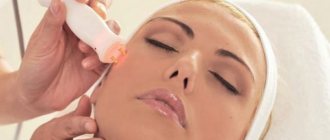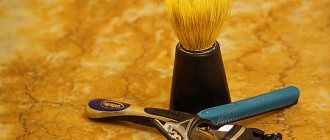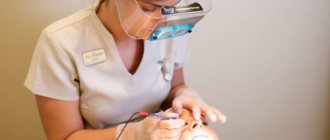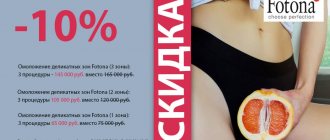The Center for Laser Aesthetic Phlebology treats the entire spectrum of venous diseases at the highest level. Having the capacity of a multidisciplinary hospital and the autonomy of an outpatient center, our doctors in a short time carry out highly informative diagnostics and low-traumatic treatment of all types of varicose veins, venous thrombosis and their consequences, and will also help in solving a variety of cosmetic problems of the vascular profile.
Complete treatment of all forms of varicose veins today is unthinkable without a combination of modern techniques: microsurgical techniques, sclerotherapy, phlebological and transcutaneous laser. It is the use of the listed methods that makes it possible to eliminate not only the cause of the appearance of varicose veins, but also the smallest cosmetic problems, including spider veins and pigmentation.
Our department has at its disposal the latest American laser platform Cutera Xeo, equipped with a neodymium laser using Vascular and Genesis technology and a short wavelength laser - LimeLight.
The essence of laser treatment for varicose veins
Endovasal laser ablation of leg veins is one of the modern types of medical elimination of the disease. With the introduction of the latest techniques that operate on the basis of the laws of physics, conservative therapy and surgical excision of varicose veins of the lower extremities has become possible for many patients.
The main purpose of endovascular laser coagulation (EVLC), like other low-traumatic methods, is to eliminate:
- Cosmetic defect.
- Symptoms and complaints.
- Lymphovenous stagnation.
- The occurrence of complications in the form of blood clots (varicothrombophlebitis, phlebothrombosis), trophic changes in the dermis, ulcerative lesions, hyperpigmentation, liposclerosis, bleeding from varicose veins.
During laser removal of varicose veins, a light guide is inserted into the narrow vascular lumen. Under its influence, the affected area of the vein is sealed, which, after time, quickly and easily resolves.
Laser removal of varicose veins is a fairly well-known method that does not provoke the development of complications after surgery and does not contribute to the recurrence of the disease. This type of operation is performed without damaging the integrity of the dermis and without the use of anesthesia, is low-traumatic and does not require long-term recovery. The main goal of the operation is to restore physiological blood flow and eliminate aesthetic defects with minimal damage.
Laser removal of varicose veins on the legs: indications and contraindications
Thermal laser correction of thinned venous walls is recommended in the early stages of varicose veins development. This will allow you to get rid of the disease in the shortest possible time and prevent the development of relapse.
Laser treatment of varicose veins is indicated in the following cases:
- Varicose veins with dysfunction of the trunks of the great or small saphenous veins.
- Pronounced signs of the disease: heaviness, swelling, pain in the legs, deterioration in the patient’s quality of life.
- Trophic disorders of the skin.
- The presence of ulcerative skin lesions.
- Obtaining a negative result when carrying out conservative treatment methods.
Contraindications for laser excision of leg veins are divided into:
- Absolute: predisposition to thrombosis and thrombophlebitis, chronic dysfunction of blood flow and lymph circulation in the lower extremities, significant damage to the walls of the veins.
- Relative: chronic pathologies, dermatological inflammation at the site of varicose veins, pregnancy, lactation, excess weight.
The advisability of endovenous laser coagulation is decided by a phlebologist or vascular surgeon. In addition to the clinical picture of varicose veins, the doctor takes into account the presence of chronic diseases, the general health of the patient and contraindications for laser treatment of leg veins.
Stages of surgery to remove varicose veins on the legs: price and technology
When varicose veins are diagnosed, surgery is performed using a high-tech innovative laser, monitoring this process using an ultrasound duplex scanner. The specialist sees the direction of the electrode on the monitor and, if necessary, adjusts the course of the manipulation.
Laser treatment is carried out by an angiosurgeon or phlebologist in the office of a medical clinic, observing all the rules of asepsis and antisepsis. The duration of the procedure varies from half an hour to an hour. After surgery, the patient can immediately leave the medical facility.
Laser removal of varicose veins on the legs is carried out in three stages. During the preparatory stage, a full examination and preparation of the skin area at the operation site is carried out.
The main stage is the actual operation itself. Doctors adhere to the following technology:
- The operated area is marked.
- It is treated with disinfectants.
- Local anesthesia is performed.
- The venous vessel is punctured with a special needle.
- A probe with a laser emitter at the end is inserted into the lumen of the vein.
- Obliteration is performed. Laser radiation glues the diseased vessel together.
The final stage includes applying an aseptic dressing to the puncture site. The field is bandaged with an elastic bandage.
The next day after the operation, in order to monitor the correct resorption of blood clots, the attending physician performs a duplex scan. The course of treatment depends on the number of affected areas, their location and the general condition of the vessels and can be carried out five to seven to ten times.
The cost of surgery to remove varicose veins on the legs depends on the scale of the disease and the degree of its development. Also an important factor is the level of classification of the clinic and the attending physician.
Rehabilitation: recovery after vein surgery
In the postoperative period, the recovery stage is extremely important, which consists not only of taking the prescribed medication. After vein surgery, the attending physician will select a rehabilitation regimen. A lot depends on how true it is, and how responsibly the patient will follow it. And, most likely, then you won’t have to think about what to do after vein surgery, which entails complications. The rehabilitation period is individual in each individual case. It is divided into 2 stages: inpatient and outpatient. The inpatient rehabilitation stage lasts from 3 hours to 3 days, depending on the method of surgical intervention chosen by the doctor. And outpatient, depending on the postoperative dynamics.
General recommendations for recovery boil down to following the following comprehensive program:
- use of compression hosiery;
- restoration of physical activity (gymnastic exercises);
- treatment with local remedies;
- proper diet and nutrition;
- maintaining a healthy lifestyle.
Rehabilitation after leg vein surgery
Medical compression stockings after vein surgery
To reduce swelling, normalize blood circulation and eliminate pain in the veins, it is necessary to use compression stockings. Elastic underwear after vein surgery prevents venous stagnation and thrombus formation.
!
The first days after vein surgery, it is imperative to use an elastic bandage, and this must be done around the clock.
The bandaging area should cover the entire limb from the fingers to the inguinal fold. The leg should be bandaged once a day, in the morning. If the bandage has slipped or the distributed pressure is disturbed, the bandage must be reapplied. In order for the compression to be correctly distributed, you need to know how to bandage your leg correctly, especially after vein surgery:
- ankle – 100% compression;
- drumstick – 70%;
- knee – 50%;
- lower thigh – 40%, upper – 20%.
Degrees of compression when bandaging the leg
The use of compression stockings is possible after surgery to remove a vein 3-5 days later. The degree of compression is determined by the doctor, but most often it is class two. The level of pressure produced in this case will be 23-32 mmHg. Art.
The doctor will also determine how long you need to wear stockings after vein surgery. The most common use of elastic compression is from 1 to 6 months, depending on the individual characteristics of the patient.
Expert opinion
Sometimes, when wearing compression hosiery in the ankle and ankle area, the leg becomes numb; this is possible after surgery on the veins. This is due to damage to small nerves. This skin sensitivity disorder will go away in 1-2 months.
Vascular surgeon, phlebologist
Osipova Ekaterina Yakovlevna
What is best to use after surgery to remove varicose veins?
Cream or ointment for veins, which is better to use after surgery?
For therapeutic and prophylactic purposes, the use of local external agents is widespread. There are different forms of release - ointment, cream and gel. All of them have a venotonic effect and have an analgesic effect. Some of them prevent the development of inflammatory processes.
The composition of the funds may be:
- natural (contains extracts from the following medicinal plants: horse chestnut, ginkgo biloba, green tea, wormwood, lingonberry, arnica and red grape leaves);
- chemical (the products are based on heparin (Heparinum) and troxerutin (Troxerutinum).
NORMAVEN® Leg cream is excellent for preventing the development of unpleasant consequences after removal of veins on the lower extremities. The product was developed by professionals from the pharmaceutical company VERTEX, has undergone clinical studies, has proven itself among phlebologists and has all the necessary documents and quality certificates.
At the same time as using compression hosiery, it is more convenient to use products that have a non-greasy base, so as not to damage the fibers of the products. Therefore, ointments are not entirely suitable for these purposes.
!
It is worth noting that the application of all products is impossible if the integrity of the skin is damaged.
Exercises and gymnastics after vein surgery
From the first day of rehabilitation, it is important to give moderate physical activity to the operated limb. There are certain exercises after vein surgery. They will help tone up the blood circulation in the legs and serve as an excellent prevention of blood clots.
The first exercises include flexion and extension of the knee joint, as well as rotational movements of the feet. Then they can be supplemented with the gymnastic exercise “scissors” (lying on your back, holding your arms along your body, legs straight, toes pointed away from you, crossing your legs one by one) and the “bicycle” exercise (rotating your legs while lying on your back).
Expert opinion
Many people are concerned about whether sports are contraindicated after vein surgery? Since bed rest is not recommended in the prevention of postoperative consequences, and it is advisable to gradually develop the limb from the first hours, sports, of course, are allowed. Only the load should be gentle, after which the legs do not hurt.
Vascular surgeon, phlebologist
Osipova Ekaterina Yakovlevna
After surgery, when the veins have been removed, preventive jersey with compression class 0 can be used during sports. It exerts a minimum level of pressure - 15-18 mm Hg. It improves the rate of blood outflow from the lower extremities, maintains the venous walls of blood vessels in a normal state and protects against relapses.
Diet and nutrition after leg vein surgery
During the rehabilitation period, nutrition must be adjusted. The diet should include foods that have a positive effect on the venous walls and reduce blood viscosity. Products containing Vitamin C meet these requirements: rose hips, citrus fruits, black currants, kiwi, sea buckthorn, etc. Seafood products have a beneficial effect on the condition of blood vessels: shellfish, crustaceans, algae, etc. They all contain polyunsaturated fatty acids, which makes them healthy. In addition, these are low-calorie products, and maintaining normal weight is also an important task assigned to the patient. It is better not to drink alcohol after vein surgery, as it has a detrimental effect on the body, including the condition of blood vessels.
Vitamin C to strengthen blood vessels during the postoperative period
In order to strengthen blood vessels and as an additional source of Vitamin C, niacin, rutin and other active ingredients, you can use venotonics based on herbal ingredients.
Leading a healthy lifestyle
Regardless of what kind of surgery the patient has undergone, the main recommendation will always be to maintain a healthy lifestyle. You should give up bad habits, balance your work and rest schedule after vein surgery, be physically active and strengthen your body.
Sources:
- RECURRENCE OF VARICOSE DISEASE. CAUSES OF APPEARANCE, METHODS OF DIAGNOSIS AND TREATMENT. Safonov V.A., Gromatsky D.F., Nenarochnov S.V., Sherov R.Z. // Siberian scientific medical journal. – 2013. – No. 3. – P.46-51.
- SURGICAL TREATMENT OF PATIENTS WITH VARICOSE DISEASE OF THE LOWER LIMB. EVOLUTION OF THE PROBLEM - PAST AND PRESENT. Bockeria L.A., Mikhailichenko M.V., Pryadko S.I., Parikov M.A., Kovalenko V.I. // Annals of surgery. – 2014. – No. 6. – P. 5-12.
- https://www.researchgate.net/publication/287875304_Lymphatic_complications_after_varicose_vein_surge…
- https://emedicine.medscape.com/article/462579-treatment
- https://www.dovepress.com/saphenous-vein-harvest-wound-complications-risk-factors-identification-pee…
- https://www.scirp.org/journal/paperinformation.aspx?paperid=78485
For an accurate diagnosis, contact a specialist.
Subtleties of rehabilitation
The duration of the postoperative period after endovenous laser coagulation is 5–7 days. In order to reliably record the therapeutic effect throughout the entire rehabilitation, it is recommended to strictly follow all medical recommendations and prescriptions.
Immediately after surgery, patients may experience pain in the area of the procedure, minor bruising, discomfort, and a feeling of tension when straightening the limb. Hyperthermia may also develop.
Full recovery occurs within a week. It is possible to speed up the process of restoring the condition of veins and blood vessels by following the following recommendations:
- Eliminate bad habits.
- Take daily walks lasting more than 3 hours.
- Stick to a proper and healthy diet.
- Avoid wearing high-heeled shoes.
- Avoid excessive physical activity.
- Take a course of taking phlebotonics and venotonics.
- Drink vitamin and mineral complexes.
- Do not carry out thermal procedures.
- Limit visits to saunas and hot baths.
Strict adherence to the basic rules of rehabilitation will allow you to quickly recover after surgery and eliminate the development of complications. An important factor during the rehabilitation period is wearing special compression garments, the degree of compression of which is discussed in advance with the attending physician.
What happens after the procedure
After receiving the service, the patient does not need rehabilitation measures or special procedures and can lead a normal lifestyle. There are no restrictions on physical activity. You can sunbathe after 7-10 days from the procedure.
As a rule, one session is enough to achieve results, but there are cases when manipulations in several stages are possible. If it is necessary to carry out several sessions of laser removal of veins on the temples and under the eyes, then repeated actions on the same areas are performed no earlier than after 1-1.5 months.
To maintain the long-lasting effect of the procedure, it is recommended to follow a number of preventive measures:
- Maintaining a healthy lifestyle.
- Active dynamic physical education (walking, step, cycling, swimming).
- Body weight control.
- Timely treatment of pathologies of endocrine organs, liver, heart.
Advantages and disadvantages
Endovasal laser ablation has some advantages over classical removal of venous vessels:
- Speed of the operation.
- Short recovery period.
- Lack of preliminary preparation.
- No hospital bed stay required.
- There are no scars or scars.
- No bleeding occurs.
- Minimal risk of relapse.
- There is no general or spinal anesthesia.
- Trophic changes are not a contraindication for laser treatment.
With competently performed endovasal laser coagulation, the patient does not notice any side effects. Phlebologists recommend limiting trips to the bathhouse, solarium, and beach for seven days after the procedure.
There are also negative aspects of laser treatment. If the diameter of the vein is large, it is impossible to perform surgery using a laser; the skin has to be cut, which subsequently causes scars on the skin.
As a rule, the size of the venous vessel is measured before laser treatment. In this case, phleboectomy is performed. The main disadvantage is the high cost of laser surgery.
Preparation for the procedure
An important advantage of laser vein surgery is that there is no need for special preparatory measures. Only a standard examination is required, including:
- general blood and urine analysis;
- test for clotting and blood sugar;
- blood biochemistry;
- testing for HIV and sexually transmitted diseases;
- determination of blood group and Rh factor;
- fluorography;
- consultation with a therapist and phlebologist.
Before the operation begins, the doctor performs an ultrasound, with the help of which he notes the ducts dilated by varicose veins. The patient is also given a sedative to relieve fear and tension.
Laser treatment of varicose veins on the legs: reviews
- Maria. 23 years old. Varicose veins of the lower extremities, unfortunately, are a chronic disease and therefore another vein may protrude near the treated one. In the postoperative period, it is recommended to wear compression garments for several months. In this regard, the operation should be performed in the autumn-winter period, when wearing hosiery does not cause discomfort.
- Svetlana is 35 years old. I encountered varicose veins in my legs during pregnancy. Initially, the doctor prescribed drug therapy. But, after childbirth, the disease progressed and laser treatment was recommended. I was very pleased with the procedure. The recovery was quick and painless.
- Mikhail is 51 years old. After diagnosing grade 2 varicose veins in the legs, laser coagulation was prescribed. The operation was performed under local anesthesia. After 2 hours, he was released from the clinic to go home. Following all medical recommendations, I returned to a full life within a week.
- Natalya is 39 years old. Varicose veins on the legs were treated with laser. Despite the fact that the operation itself was expensive, I was satisfied with the result. After the procedure, the leg became beautiful and healthy. There are no visible scars or terrible veins on the skin. The efficiency and aesthetics of the operation are worth the money.
Treatment of varicose veins with laser is mainly characterized by positive reviews. Both doctors and patients note the high effectiveness of this technique, its ease of perception and speed of recovery. There may be a slight sensation of pain at the time of insertion of the light guide into the vein and during the day after the operation. However, it is possible to reduce them by taking analgesics as usual.











